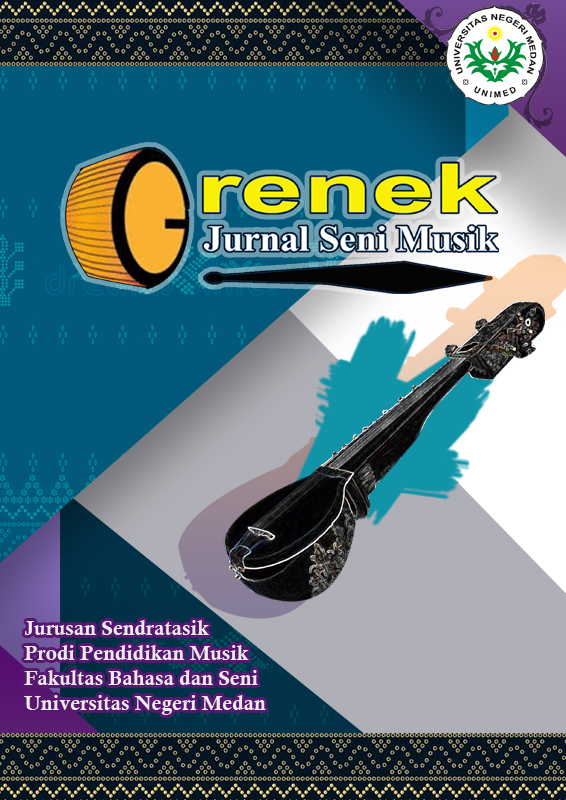Expressive and Structural Ornamentation in Handel’s Vocal Music: A Literature and Score-Based Study
DOI:
https://doi.org/10.24114/grenek.v14i1.64500Keywords:
Baroque Ornamentation, Historical Treatises, Handel's Arias, Decorative and Structural OrnamentationAbstract
This study investigates the stylistic features and functions of ornamentation in Handel’s vocal arias, addressing the challenge posed by the absence of detailed notations in his works. The research focuses on the dual role of ornamentation as both decorative and structural, aiming to bridge historical scholarship with modern performance practices. The methodology involves a comprehensive literature study of historical treatises, including works by Tosi, Agricola, and Quantz, alongside a score-based analysis of selected Handel arias to identify and interpret ornamentation practices. Findings highlight the expressive and structural functions of ornaments, such as enhancing melodic connectivity, harmonic depth, and emotional expression. The study emphasizes the performer’s discretion in applying ornaments, particularly in improvisatory contexts like da capo arias. This research contributes to understanding Handel’s compositional intentions and offers valuable insights for historically informed performance (HIP). Future studies could explore cross-genre ornamentation, technological applications, and evolving audience perceptions of Baroque vocal embellishmentsReferences
Agricola, J., & Baird, J. (1997). Introduction to the art of singing. Cambridge: Cambridge University Press.
Austin, S. (2008). Provenance:" Lean on Me!"; The Art of the Appoggiatura. Journal of Singing-The Official Journal of the National Association of Teachers of Singing, 64(3), 363-368.
Baird, J. C. (Ed.). (1995). Introduction to the art of singing by Johann Friedrich Agricola. Cambridge: Cambridge University Press.
Bigler, C., & Lloyd-Watts, V. (2005). Ornamentation-A Question & Answer Manual: For Intermediate to Advanced Piano. London: Alfred Music.
Burney, C. (1785). An Account of the Musical Performances in Westminster-Abbey, and the Pantheon, May 26th, 27th, 29th, and June the 3d and 5th, 1784: In Commemoration of Handel. London: Benefit of the Musical Fund and Sold.
Campbell, A., & Lord, A. (1962). The Singer of Tales. Comparative Literature, 14(4) 399-402.
Ceulemans, C. (2010). The reputation of baroque composers 1790-2000. Empirical Studies of the Arts, 28(2), 223-242.
Collins, M. (1973). In defense of the french trill. Journal of the American Musicological Society, 26(3), 405-439.
Cook, N. (1999). At the Borders of Musical Identity: Schenker, Corelli and the Graces. Music Analysis, 18, 179-233.
Cudworth, C. (1959). Handel and the French Style. Music & Letters, 122-131.
Dean, W. (1950). Essays on Opera. United States: Oxford University Press.
Dean, W. (1970). Handel and the opera seria. United States: Oxford University Press.
Dean, W. (1997). Production style in Handel's operas. Cambridge: The Cambridge Companion to Handel.
Donington, R. (1963). The interpretation of early music. New York: Faber.
Donington, R. (1974). A performer's guide to baroque music. New York: Charles Schribner's sons.
Donington, R. (1978). A performer’s Guide to Baroque Music. New York: Faber.
Donington, R. (1982). Baroque music: style and performance: a handbook (Vol. 10). New York: WW Norton & Company.
Ernst, K. (1972). The Response to Music. Journal of Research in Music Education, 20, 199-201.
Ferand, E. (1958). Embellished “Parody Cantatas” in the Early 18th Century. The Musical Quarterly, 40-64.
Harris, E. T. (2014). George Frideric Handel: A Life with Friends. New York: WW Norton & Company.
Haynes, B. (2007). The End of Early Music: a period performer's history of music for the twenty-first century. United States: Oxford University Press.
Hefling, S. E., & Quantz, J. J. (1987). Of the Manner of Playing the Adagio": Structural Levels and Performance Practice in Quantz's" Versuch. Journal of Music Theory, 31(2), 205-223.
Hiller, J. A. (2001). Treatise on vocal performance and ornamentation by Johann Adam Hiller. Cambride: Cambridge University Press.
Högset, J. S. C. (2001). Voice source differences between falsetto and modal registers in counter tenors, tenors and baritones. Logopedics phoniatrics vocology, 26(1), 26-36.
Ivey, D. (1970). The Science of Vocal Pedagogy. Journal of Research in Music Education, 18, 94 - 95.
Jackson, R. J. (1988). Performance practice, medieval to contemporary: a bibliographic guide. America: Music Library Association.
Jerold, B. (2008). How composers viewed performers’ additions. Early Music, 36, 95-110.
Kodenko, I. (2020). Specificity of performance of Еarly Music: historical aspect. Problems of interaction of art, pedagogy and theory and practice of education, (56), 93-105.
Kruglova, E. (2022). On Ornamentation and Improvisation in Baroque Vocal Performance. PHILHARMONICA: International Music Journal.
Lee, J. (2020). An understanding of style of baroque ornamentation in Handel’s operatic arias: a study of selected recordings (1950s–2010s). Theses and Dissertations--Music. 156.
Marx, G. T. (1988). La société de sécurité maximale. Déviance et société, 12(2), 147-166.
McMahon, P. (2014). Handel and the voice practitioner: perspectives on performance practice and higher education pedagogy. Teaching Singing in the 21st century, 263-286.
Menerth, E. (1966). Singing in Style. Baroque. Music Educators Journal, 52, 107-73.
Neumann, F. (1983). Ornamentation in Baroque and Post-Baroque music: With special emphasis on JS Bach. United Kingdom: Princeton University Press.
Parker, M. (2003). Reception of Handel Operas, Then and Now. University of Toronto Quarterly, 72(4), 850-857.
Pilcher, N., Cortazzi, M., & Jin, L. (2014). Da capo: A musical technique to evoke narrative recall. Psychology of Music, 42, 483 - 502.
Reilly, E. R. (1964). Further Musical Examples for Quantz's "Versuch". Journal of the American Musicological Society, 17(2), 157-169.
Reiter, W. (2020). 'Into the Galant: Tartini, Telemann, Quantz, and Zuccari: Ornamentation, Module Five', The Baroque Violin & Viola, vol. II: A Fifty-Lesson Course.
Reiter, W. (2020). 'Nurturing Spontaneity Ornamentation, Module One', The Baroque Violin & Viola: A Fifty-Lesson Course Volume I. 216-226.
Roberts, J. (1987). HANDEL AND VINCI'S ‘DIDONE ABBANDONATA’: REVISIONS AND BORROWINGS. Music & Letters, 68, 141-150.
Roseman, R. (1975). Baroque Ornamentation. International Double Reed Society, no. 3. www.Idrs.org
Shrock, D. (2013). Handel's Messiah: A Performance Practice Handbook. GIA Publications, Incorporated.
Spitzer, J., & Rousseau, J. (1989). Grammar of Improvised Ornamentation: Jean Rousseau's Viol Treatise of 1687. Journal of Music Theory, 33, 299.
Swain, J. P. (2023). Historical dictionary of baroque music. New York: Rowman & Littlefield.
Timmers, R., & Ashley, R. (2007). Emotional Ornamentation in Performances of a Handel Sonata. Music Perception, 25, 117-134.
Tosi, P. F., Agricola, J. F., & Baird, J. (1995). Introduction to the art of singing. Cambridge: Cambridge University Press.
Tosi, P. F., Galliard, J. E., & Pilkington, M. (2002). Observations on the florid song. New York: Stainer & Bell.
Walls, P. (Ed.). (2017). Baroque music. London: Routledge.
White Jr, R. C. (1988). On the teaching of breathing for the singing voice. Journal of voice, 2(1), 26-29.
Whytock, J. C. (2012). Handel, George Frederick (1685–1759). The Encyclopedia of Christian Civilization.
Yonan, M. (2018). 'Ornamentation', in John D. Lyons (ed.), The Oxford Handbook of the Baroque. Oxford Handbooks.
Downloads
Published
Issue
Section
License
Copyright (c) 2025 Xiong Chenchen, Yap Jin Hin

This work is licensed under a Creative Commons Attribution-ShareAlike 4.0 International License.
Authors published with the Grenek: Jurnal Seni Musik agree to the following terms:
- Authors retain copyright and grant the journal the right of first publication with the work simultaneously licensed under a Creative Commons Attribution License (CC BY-SA 4.0) that allows others to share the work with an acknowledgment of the work's authorship and initial publication in this journal.
- Authors are able to enter into separate, additional contractual arrangements for the non-exclusive distribution of the journal's published version of the work (e.g., post it to an institutional repository or publish it in a book), with an acknowledgment of its initial publication in this journal.
- Authors are permitted and encouraged to post their work online (e.g., in institutional repositories or on their website) prior to and during the submission process, as it can lead to productive exchanges, as well as earlier and greater citation of published work. (See The Effect of Open Access)








